Feature article
RECENT TRENDS IN SPENDING AND SAVINGS IN CANADA AND THE US
by F. Roy*
For a number of years, our economy has grown more vigorously than
that of the United States, with the gap widening recently for a
range of indicators–from aggregate demand to the labour market.
Real GDP per capita has grown more in Canada in the last five years,
reflecting both faster gains in GDP here and more rapid population
growth in the US. For the first time in two decades, a larger percentage
of Canadians than Americans held a job. Our unemployment rate remained
higher, as a greater proportion of our working-age population was
in the labour force than in the US.
This note focuses on differences in the spending and financial behaviour
of the four major sectors of these two economies: households, government,
business and external. The goal is to highlight some of the reasons
for our improved performance by tracing their origin back to recent
structural differences between these sectors, not to offer an exhaustive
list of all the factors contributing to this gap. Briefly, this
paper shows that spending in all non-government sectors has recently
been stronger in Canada than in the US. Moreover, the public, corporate
and external sectors are all running financial surpluses in Canada,
while these sectors are all in deficit in the US. The counterpart
of large current account surpluses in Canada and deficits in the
US is large net borrowing by non-residents from Canada and lending
to the US.
It is worth remembering that, while recently outperforming the
US, Canada had ground to make up. The recession early in the 1990s
was much more pronounced here–the year-over-year change in
per capita real GDP fell for 12 straight quarters starting early
in 1990, with the largest drop (-4.7%) in the first quarter of 1991.
In the US, it fell in only five quarters, touching a low of a 2.5%
drop during the Gulf war in 1991. However, since 1997, real per
capita GDP in Canada has consistently grown faster than the US (Figure
1). This gap emerged in most sectors of the economy, reflecting
differing attitudes to consumer spending and saving, investment
outlays by firms and government fiscal policy. The most striking
difference was in the external sector where this divergence in domestic
demand was further magnified by opposing trends in the exchange
rate.
Figure 1
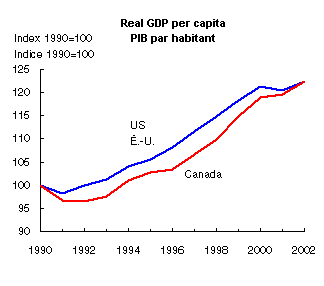
Households
While overall household spending on consumer products and housing
followed a similar track in the two countries, the composition varied.
After 1997, households in Canada spent relatively more on housing,
while those in the US spent more on consumer goods and services
(this also has important multiplier effects for other sectors, as
housing has the lowest leakage to imports). Over the last 4 years,
the growth of housing totalled 33% in Canada, versus 13% in the
US. Consumer spending on the other hand was up 16% in the US versus
14% here.
Underpinning these trends in spending was a marked divergence in
incomes and savings. Consumer spending in Canada was fed by the
growth of disposable income since 1998, reinforced by income tax
cuts early this decade. The personal savings rate was steady at
about 5%, while debt rose less rapidly than in the US. Canadian
mortgage and consumer credit debt as a percentage of disposable
income rose steadily by about 20 points in the 1990s to 99.0 in
2002. Heavy investment in housing meant that households overall
were net borrowers over the last year, despite the positive savings
rate.
Consumer spending in the US, however, was supported by a drop
in personal savings (from 5% in 1998 to a low of just over 2% of
disposable incomes by 2001) and an acceleration in debt loads. A
number of factors encouraged households in the US to reduce savings
more than in Canada, notably the wealth effect from having more
assets in the stock market boom up to 2000 and a rising exchange
rate, which helped to lower the price of consumer durable goods
by nearly 9% since 1998 (versus a 1% dip here in Canada). The sharpest
tax drop in 50 years early in 2002 gave a temporary lift to incomes,
helping to boost spending and re-build savings back nearly to Canada’s
level, although by late in the year this stimulus had begun to wear
off. Less savings and lower taxes helped offset a weaker underlying
trend of personal income growth compared with Canada, reflecting
their less robust labour market. This also followed a loss of nearly
$80 billion in equity wealth by American households in 2001 following
the stock market crash. Meanwhile, household debt as a percent of
disposable income rose nearly 30 points since 1992, including a
jump from 104.4 to 122.4 in just the last four years.
Figure 2
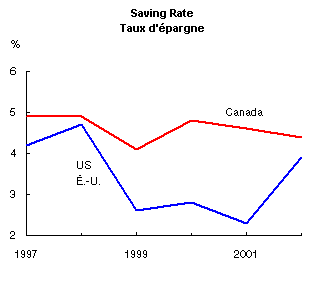
Business
Firms in the two countries also behaved differently, to Canada’s
advantage. The share of nominal GDP devoted to business investment
was larger in Canada since 1997 and the gap grew after 2001. (Figure
3). This held true despite the surge in US spending on machinery
and equipment at the peak of the technology boom, which lifted its
portion of nominal GDP from 7.2% in mid-1992 to 9.8% in the second
quarter of 2000, before the bust on both sides of the border. Canada
benefited from the much larger role played by non-residential structures,
nearly 5% of GDP, driven by the energy sector. Utilities and oil
and gas reached 40% of all such investment in Canada during the
1990s, rising to over half by 2002, while they remained below 30%
of outlays for non-residential structures in the US. Overall, the
2.6% of US GDP devoted to structures last year was the lowest since
1945 (when it was 1.5%, as the war effort consumed most output),
reflecting their glut of unused plant and office space.
Figure 3

Firms in Canada were better positioned to spend relatively more
because of much stronger earnings. (Figure 4). Coming out of the
severe recession here in the early 1990s, corporate profits before
taxes tripled in Canada over the past decade, versus a 66% gain
in the US, with much of this gap originating in manufacturing (compared
with 1988, the gap is only 93% versus 74%, a measure of the severity
of our slump in the early 1990s). The gap widened recently, as profits
held steady here over the last three years, while recession eroded
them in the US.
Figure 4
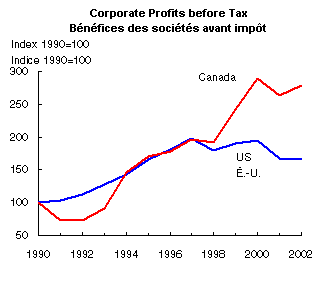
Another measure of the buoyancy of profits in Canada: firms here
were large net lenders in the last two years, despite the relative
strength of spending, while in the US they continued to borrow even
as they slashed outlays. Overall, firms in Canada had a surplus
equivalent to 2.1% of GDP, the largest amount on record back to
1961. The corporate sector typically was a net lender in the 1990s,
a reversal from the previous three decades when it was almost always
a net borrower. In the US, companies remained net borrowers throughout
the 1990s and into 2002, partly because they issued debt and retired
equity (the opposite of Canada).
The greater willingness of firms to spend on investment in Canada
was reflected in more jobs. The recent divergence in employment
originated largely in a much smaller drop in Canada for jobs in
the manufacture of industrial machinery and electronic products
after the surge in ICT investment faded.1
This partly reflects the better performance of profits and capacity
utilization in Canada, especially in manufacturing.
Government
Public spending slowed in both Canada and the US throughout the
1990s, reinforced by lower interest rates since 1996. All government
spending (including interest payments) relative to GDP in Canada
fell 12 percentage points from its peak of 52.1% in 1992 to 39.8%
in 2002. Over the same period in the US, it eased from 32.4% to
29.9% (Figure 5). Two-thirds of the dip in the US reflected lower
interest payments on debt, while in Canada two-thirds of a much
larger drop originated in lower program spending. Program spending
(all governments outlays excluding interest payments) in Canada
fell from 42.8% to 34.0% of GDP over the last decade, while it dipped
3 points in the US before recovering in the last two years to 28.0%.
Provinces and the federal government led these cuts in Canada.
Figure 5
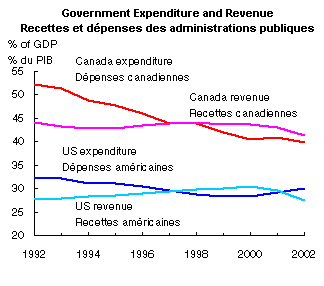
Government revenues remained stable in Canada and the US through
the 1990s, even as spending fell. In Canada, however, they then
declined from 44% of GDP in 1998 to 41.4% in 2002, largely due to
income taxes, which, as a share of our GDP, fell to their lowest
level since 1986. This drop reflected cuts to tax rates, as the
tax base itself was swollen by more jobs. Tax collections by local
government continued to grow, but not enough to meet the growing
demand for services, resulting in their third-largest deficit since
data began in 1961. Personal income taxes last year fell 14% in
the US, due to lower rates, fewer jobs and falling stock prices,
after levelling off in 2001.
After moving to a surplus in the 1990s, the trend of the budget
balance was also different in Canada and the US from 2000 to 2002.
Altogether, US governments shifted from a surplus equal to about
1% of GDP to a deficit of over 3%, while governments in Canada maintained
a surplus of about 1%. In the US, government current and capital
spending accelerated over the last two years to a 16-year high of
4.4% last year, led by a 9.3% surge in the volume of defence spending
fuelled by the war on terrorism. Defense spending had fallen steadily
in the 1990s, the peace dividend from the end of the cold war.
The better fiscal position in Canada also reflects the reduction
of debt levels since the mid-1990s, when part of every federal surplus
was devoted to paying off past debt. Most provinces also acted to
reduce their debt load. From 1997 to 2001, government debt outstanding
in Canada fell nearly $100 billion (or 12%), while it was unchanged
in the US (servicing their debt, however, cost less as interest
rates tumbled).
External
The US current account deficit ballooned from nearly zero in 1991
(when the US received large transfers to pay for the Gulf war) to
$204 billion in 1998 to $503 billion in 2002, equal to 5% of GDP.
On top of a rising exchange rate, the structure of domestic spending
in the US was more favourable for imports than in Canada. Almost
half the US external deficit originated in surging demand for consumer
goods, with the rest about equally distributed between energy products
and autos. Conversely, Canada’s surplus in trade in goods
with the US trended up after the implementation of the Free Trade
Agreement in January 1989, with the surplus rising to over 8% of
GDP from 2000 to 2002. While US exports stagnated after 1999, ours
grew by a further one-quarter. For the whole decade, Canadian exports
and imports rose for every major commodity group, a sign of our
greater integration into the world economy which positioned us to
reap the benefits of trade through specialisation.
The US deficit with the rest of the world reached a record high
of $432 billion. Along with China, Canada profited the most from
American demand for imports. By comparison, at the start of the
1990s Canadian and Japanese exports to the US were about the same:
by 2002, our exports to the US were nearly twice as large, and the
largest of any nation. Mexico also benefited from the increased
US propensity to import, to become the third largest exporter to
the US in 2002 after China. Mexico increased its exports to the
US, especially in the auto sector, which now ranks behind only their
exports of machinery and equipment. Its auto exports soared from
the equivalent of 10% of Canada’s in 1990 to 37% in 1998 and
52% in 2001, when Mexico’s auto exports rose even as Canada’s
fell 10%.2 Japan is now the fourth
largest exporter to the US.
China is closing in on Canada for first place among exporters
to the US. US imports from China rose rapidly, bypassing Japan from
third overall in 1990 to second in 2002. In 2002 alone, China’s
exports to the US surged almost 15%, while US shipments to China
rose only 4%.3 This widening trade
gap has persisted since 1997, leaving China with the largest share
of the US trade deficit, nearly one-quarter in 2002.
Figure 6

Summary
Figure 7 summarizes the financial balances of the public, private
(total household and corporate) and external sectors in Canada and
the United States.4 It shows the
upturn in the financial surplus of all three sectors in Canada by
the end of the 1990s.5 Conversely,
two of the three sectors in the US were running deficits. The US
current account deficit continued to rise to record levels. The
largest turnaround was for government, which, after a brief spate
of surpluses, started to run deficits comparable to the mid-1990s
at nearly 4% of GDP. Overall, their private sector returned to a
net lending position, as a sharp increase in corporate borrowing
was offset by an acceleration in household lending. These trends
have begun to be reflected in the relative performance of GDP, with
Canada were out-performing the US since 1997 due to stronger demand
in all non-government sectors.
Figure 7a
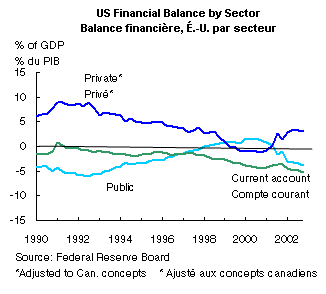
Figure 7b
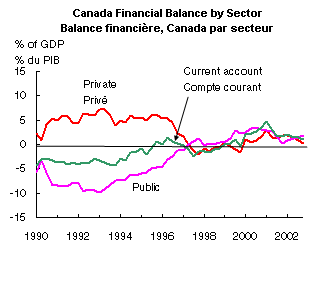
Recent feature articles
Notes
* Current Analysis (613) 951-3627 or e-mail at ceo@statcan.ca.
1 See G. Bowlby, “The labour market: Up north, down
south.” Canadian Economic Observer (Catalogue 11-010-XPB),
January 2003.
2 Canada’s auto sector has generally not fared well in recent
years in the US market. After 1998, American auto imports have doubled
from South Korea and risen 32% from Mexico, 25% from the European
Union, 19% from Japan, but fell 7% from Canada.
3 American imports from China were concentrated in computers,
printers and other office equipment. US exports to China were driven
by machinery, aircraft, medical supplies and plastics. Aircraft
were the fastest-growing export to China, a measure of the speed
of its development. China, while accounting for only 4% of global
output, contributed 17% of global growth last year.
4 US data show a deficit for the overall private sector (as seen
recently in The Financial Times, April 2, 2003, p.13 and in “The
Perfect Fiscal Storm” by L.R. Wray, p.59 in Challenge, Jan.-Feb
2003). In this paper, we adapt the US data to Canadian concepts
by excluding consumer durables, which results in a small surplus.
5 Net lending in the economy is always zero as financial
surpluses in one sector are loaned to other sectors. In Canada,
the net lending by the private and public sectors is offset by net
borrowing by non-residents, as Canada lends its current account
surplus to the rest of the world. In the US, non-residents lend
large amounts to domestic borrowers.
|


































